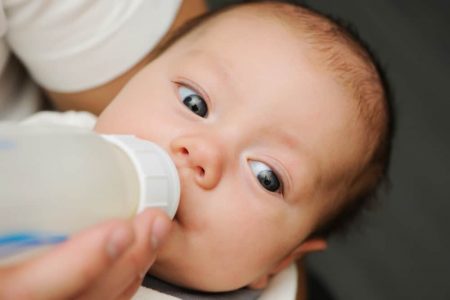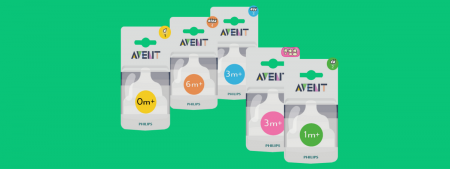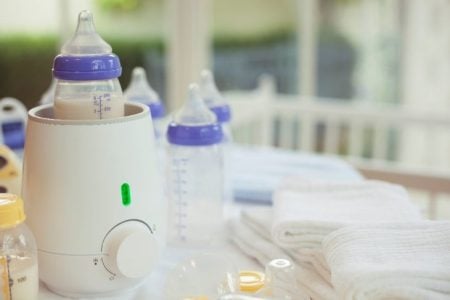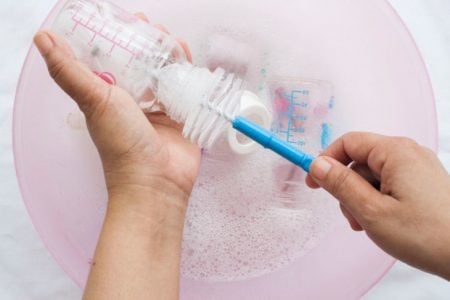We reviewed advice from pediatricians and lactation consultants to help you decode the signs. We will cover the flow differences for formula and breastfed babies, how to spot readiness cues, and why your baby might be fussy at the bottle.
Key Takeaways
- Consider the feeding method: Formula-fed babies usually move up in flow speed as they age, while breastfed babies often stay on slow-flow nipples to mimic breastfeeding.
- Watch behavior, not just the calendar: Age guides are helpful, but signs like nipple collapse, aggressive sucking, or frustration are better indicators that it is time to switch.
- Know the signs of too fast: If your baby is choking, gagging, or has milk dripping from their mouth, the flow is likely too strong.
- Assess your pump flow: Exclusively pumping moms should usually stick to slow-flow nipples and paced feeding to prevent overfeeding.
When To Switch Bottle Nipple Sizes
Choosing the right nipple size for your baby’s bottles depends on a few variables. You need to consider if they are drinking breast milk or formula, their age, and their physical cues during feeding. Essentially, the nipple size dictates how fast the milk flows into their mouth.
For A Formula Fed Baby
Most bottle brands provide an age chart for their nipple levels. If you tossed the packaging, check the manufacturer’s website.
In general, faster nipples are designed for older babies who have bigger stomachs and can swallow more volume efficiently. Most brands stick to this breakdown:
- Slow flow (Level 1): 0-3 months
- Medium flow (Level 2): 3-6 months
- Fast flow (Level 3): 6-12 months
However, every baby is different. Some newborns have a strong suck and need a medium flow early, while some older babies prefer a slower pace. Instead of relying solely on the calendar, watch for these signs that your baby is ready to upgrade:
- They suck aggressively: Your baby seems to be working incredibly hard to get milk out.
- The nipple flattens: The suction is so strong that the nipple collapses during the feed.
- They get frustrated: You notice squirming, kicking, or batting the bottle away.
- Feeds take forever: It takes your baby 30 minutes or longer to finish a standard amount.
- They eat less frequent amounts: They give up on the bottle early but act hungry again an hour later.
If your baby seems content and finishes their meal in about 15 to 20 minutes, stay put. There is no rule saying you must increase the flow just because they turned three months old.
Conversely, if you move up a size and your baby starts gagging, coughing, or milk spills out of the corners of their mouth, the flow is too fast. Switch back to the slower nipple immediately. You should also downgrade if your baby seems gassy or uncomfortable after eating, as gulping too fast can upset their digestion (1).
For A Breastfed Baby
The rules change when you are bottle feeding a breastfed baby. Experts generally recommend using slow flow or “newborn” nipples for the entire duration of your bottle-feeding journey.
When nursing, a baby has to work to extract milk, and the breast flow is usually slower and more consistent than a bottle. If you introduce a fast-flow nipple, the baby gets an instant reward with zero effort. This can lead to a “bottle preference” where they begin to refuse the breast because it requires more work.
To keep breastfeeding successful, the bottle flow must mimic the breast. Caregivers should practice “paced feeding.” This involves holding the baby upright, keeping the bottle horizontal so the nipple isn’t fully filled (forcing the baby to suck to get milk), and taking frequent breaks.
While most breastfed babies stay on Level 1 nipples, there are exceptions. If a mother has a forceful letdown and a very fast natural milk flow, the baby might get annoyed by a slow-flow bottle. If your baby nurses in 5 minutes flat but takes 45 minutes to finish a bottle, you might consider moving up one level to match your natural speed.
What If I’m Exclusively Pumping?
Breast milk digests faster than formula, but the risk of overfeeding remains high with bottles. Even if you are exclusively pumping, experts recommend sticking with slow-flow nipples. This prevents the baby from chugging the milk too quickly, which can stretch their stomach and bypass their natural fullness cues.
Feed on demand rather than a strict schedule, and aim for feeding sessions to last about 15 to 20 minutes. This gives your baby’s brain enough time to register that they are full (2).
Other Considerations
If your baby hates the bottle but the flow speed seems correct, investigate the hardware. You might need to change the nipple shape (standard vs. wide-neck), the material (silicone vs. latex), or try a specialized orthodontic shape.
A “preemie nipple” doesn’t necessarily mean it has a slow flow. And some brands don’t go by age but rather label the nipples by levels. You’ll need to read the packaging or even check the manufacturer’s website to get a feel for what these labels mean.
Editor's Note:
Michelle Roth, BA, IBCLCRemember that the equipment isn’t always to blame. Your baby might be teething, distracted by their surroundings, or feeling under the weather. Some babies are also particular about milk temperature, or you might have high lipase in your breast milk which alters the taste (3).
FAQs
Keep The Size Right
Nailing the right nipple flow makes feeding time a bonding experience rather than a battle. Remember that age is just a number; your baby’s behavior is the real guide.
Assess your unique situation. If you are breastfeeding, slower is usually better. If you are formula feeding, watch for frustration or collapse. If your baby is happy and healthy with their current setup, don’t feel pressured to change a thing.










